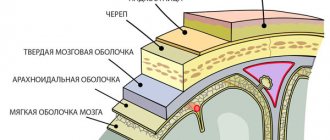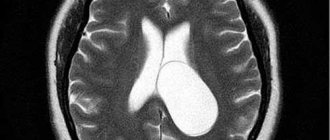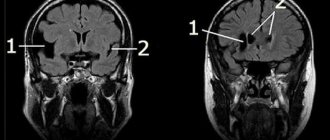Do they take you into the army with a cyst? Difficult living conditions, increased physical activity and the specific nature of military service can provoke complications in the development of cysts and irreversible health consequences. The cyst can have different forms, depending on the location, structure, and duration of the disease. Based on these forms, a decision is made on whether the army and the army are compatible, whether a deferment or release from service is due.
The Military Medical Commission must submit documents confirming the diagnosis and the presence of a cyst. To confirm that you have a cystic disease, you need to have the results of an ultrasound, x-ray, MRI, and a certificate from your doctor. It will also be mandatory to have an outpatient card with a description of complaints, test results and diagnosis.
Brain cyst
The presence of cystic fluid formations in the brain area cannot but cause concern. Especially in the presence of symptoms, for example, convulsions, pain symptoms, visual and hearing impairment, and others. It should be noted that a cyst is a non-oncological formation. For diagnosis, in addition to magnetic resonance imaging images, images with the introduction of contrast are used to accurately determine the location and to distinguish it from a tumor. The causes of the formation of brain cysts can be divided into three - congenital anomalies, traumatic or a consequence of another disease. How do Russian conscripts with a brain cyst undergo examination before the army? Military examination of any disease is based on an assessment of the functioning of the affected organ or body system and the severity of the disorders. Thus, to evaluate a conscript for military service with a brain cyst, doctors carefully study the presence of emotional, intellectual, neurological and other clinical manifestations.
Thyroid cyst
A thyroid cyst that was diagnosed in a conscript and the army - are they compatible or not? To answer this question, you need to understand what this disease is.
People begin to talk about the formation of a thyroid cyst when an ultrasound scan shows a palpable lump in the area of this human organ. Pathology manifests itself exclusively at the stage when the neoplasm is already quite large. Symptoms are not pronounced in the presence of formations with a diameter of 3-5 mm.
Consequences of disease progression:
- Respiratory dysfunction;
- Feeling of a lump in the throat;
- Difficulty swallowing food;
- Pain sensations radiate to the lower jaw and ear.
In the area of the thyroid gland, as the formation increases, re-infection and swelling occur. The cervical nodes may also enlarge, and pus may collect in the tumor.
If this pathology is detected in a conscript, the military draft board, on the basis of the “Schedule of Diseases,” exempts the young man from military service.
Cerebral cyst and the army
A cerebral cyst forms at the site of a dead area of the brain and is filled with cerebral fluid. A similar name for cysts is retrocerebellar cysts, which are located behind the cerebellum in an anatomical recess. Certain cases of cerebral cysts of the brain are regulated by Article 23 of the Schedule of Diseases. The general explanation to the article states that the commission’s doctors will use this article when examining cerebral and other cysts. The examination of conscripts with congenital brain abnormalities is described in detail in paragraph “d” of the article. This paragraph allows the application of fitness category “B-4” to a conscript with congenital cerebral and/or spinal cysts without impairment of brain function. If a cyst is detected on the tomograph image, but it does not manifest itself in any way, does not bother, and there is no pain, then the conscript is considered fit for this disease and will be sent to serve with some restrictions (in a certain branch of the military). If an intracerebral (retrocerebellar or cerebral) cyst causes moderate or significant disruption of the nervous system, then the conscript has the right to expect to be released. Fitness category “D” or “B” is issued upon confirmation of significant damage to the nervous system - it is in these cases that a person with a cyst in the brain is not accepted into the army.
Help
If you have problems with the call and you don’t know how to solve them, ask our specialists questions. Lawyers working on the site provide legal assistance, provide valuable recommendations and clear answers on any topic related to the army.
The development of neoplasms in tissues always causes internal concern, since there is a high probability that it is of an oncogenic nature. Even if doctors have determined that a benign cyst appears in the form of a tumor, everything possible must be done to stop its development, get rid of it, or maintain it at its current stage.
Along with its apparent harmlessness, a cyst can cause irreversible functional changes in the body. As it develops and increases in size, a bubble of fluid can interfere with the normal blood supply to neighboring organs, which often leads to necrosis or hemorrhage. Therefore, young men with a similar diagnosis try to protect themselves from provoking environmental influences.
In particular, the question arises: “Do they enlist in the army with a cyst?” It is known that military service takes place in a slightly different mode, which cannot but affect the condition of the body as a whole. It is not uncommon for physical activity to cause a relapse of a latent disease. Today, much attention is paid to the health of conscripts. If the disease is diagnosed in advance, then all deferments provided for by law will be provided to the young man.
But we should not forget that members of the expert commission must attest to the diagnosis already made, but are not required to find and define the disease. Consequently, the ranks of the Armed Forces are still filled with conscripts who are not even aware of the hidden and asymptomatic illness.
Passing a medical examination with an arachnoid cyst
If a non-oncological formation is detected, and the cause of its occurrence was any external influence (trauma, concussion, etc.), then the examination takes place according to Article 25 of the Schedule of Diseases. The article also examines the presence of hydrocephalus - a violation of the outflow of cerebrospinal fluid from the ventricles of the brain, which accumulates in the form of cysts. In addition, arachnoid and porencephalic cysts of a post-traumatic nature are also taken into account. An arachnoid cyst forms in the area of the arachnoid membranes of the brain. Porencephalic cysts are a rather rare developmental anomaly; in some cases, the cyst can communicate with the ventricles of the brain.
It is understood that if the cyst affects one or another area of the brain, then various complications may appear in the form of: unsteady gait, speech impairment, muscle hypertonicity, convulsions without loss of consciousness, loss of the ability to read and loss of landmarks, tinnitus, hearing impairment, etc. type of visual impairment. There may be many more symptoms than those listed; the conscript will not necessarily experience them if the cyst does not affect areas of the brain. Intracranial pressure, in turn, can cause its own symptoms. This can be a headache of varying intensity; in addition, nausea, drowsiness, loss of appetite, inattention, and papilledema are observed. The intensity of pain and symptoms will determine when someone with a brain cyst is not accepted into the army. The reason for release is really significant: the presence of a cyst or the formation of fluid requires treatment, observation by a neurologist, sometimes surgery is required, after which rehabilitation and clarification of the presence/absence of symptoms are necessary. The simplest thing you can pay attention to is the presence of headaches, worsening of the condition during physical activity, etc. In any case, the military registration and enlistment office will require a complete medical history (presence of visits to the doctor, their frequency, degree of symptoms, etc.).
Diagnostics
Despite the fact that the disease has several distinctive symptoms, a whole range of measures is involved in making the correct diagnosis.
The first stage of diagnosis includes the work of a neurologist with the patient:
- studying the medical history of both the patient and his close relatives - to search for the most likely pathological etiological factor;
- life history analysis;
- collecting information regarding the course of pregnancy;
- thorough physical and neurological examination;
- assessment of hearing and visual acuity;
- measuring head volumes;
- a detailed survey of the patient or his parents (if the disease has affected a child) - to draw up a complete clinical picture and determine the time of the appearance of the first signs.
A retrocerebellar arachnoid cyst of the posterior fossa can only be detected using the following instrumental procedures:
- CT and MRI of the brain;
- Doppler scanning of head vessels;
- ECG;
- daily blood pressure monitoring;
- Ultrasound and SCT of the brain;
- electroencephalography;
- angiography of blood vessels using a contrast agent.
Electroencephalography
Laboratory tests in making a diagnosis of “retrocerebellar arachnoid cyst” are only auxiliary in nature and are limited to general clinical and biochemical blood tests.
Suitability category
Article 25 of the Schedule of Diseases considers the severity of clinical manifestations of the presence of intracerebral cysts. Fitness category “D” (not fit for service) may be considered when a conscript with arachnoid and/or porencephalic cysts experiences increased intracranial pressure with severe neurological symptoms.
People with arachnoid and porencephalic cysts are not accepted into the army if there is increased intracranial pressure with moderate clinical manifestations. Constant or periodic moderate symptoms will allow you to receive a military ID without serving - Article 25 of the Schedule of Diseases, fitness category “B”. Let us clarify that the manifestations are so diverse that there is no point in listing them. The very first thing you need to do is consult a competent doctor. The disease is complex in its manifestations, therefore, in order to be released from service, you need to prepare all the certificates and results for the entire period of the disease.
If the brain cyst is not accompanied by intracranial pressure, then the doctors of the military conscription commission consider the presence of two parameters of manifestations. Firstly, among the scattered organic manifestations there are asymmetry of cranial innervation and anisoreflexia, mild sensitivity disorders, etc. Secondly, the manifestation of asthenoneurotic symptoms and vegetative-vascular disorders is obligatory. Only if symptoms are confirmed in the conscript’s medical history (appeals for medical help), research data will enable the conscript to receive a military ID with fitness category “B” - limited fit, not conscripted in peacetime.
There is one more significant nuance indicated in the Schedule of Diseases, Article 25. A conscript with a brain cyst can receive a non-conscription category only in cases where treatment does not help, does not bring relief and the symptoms do not go away, including in the case of long-term or repeated decompensations.
Specifics of diseases
A cystic formation is a cavity that has dense walls and is filled with liquid exudate. Its structure and contents depend on the mechanism of development, age, and localization. It can be acquired and congenital, false and true (lined with epithelial tissue). There are several forms, each of which has its own symptoms and characteristics. Depending on this, it is determined whether they are recruited into the army with one or another cystic formation.
Intracranial cyst
This is a local accumulation of exudate in the meninges or substance. If the volume is small, clinical manifestations may be absent; in this case, the disease is detected only during a neuroimaging examination. With a large volume, a reduction in intracranial space is observed, which leads to hypertension and compression of brain structures. Depending on the location, several types of formations are distinguished:
- Retrocerebral.
It is formed in place of dying tissues, and is characterized by rapid filling with cerebrospinal fluid. It is fraught with convulsive, cerebral syndrome, and neurotic disorders. - Arachnoid cyst of the brain.
It is congenital or traumatic in nature and is located on the surface. The danger lies in the high risk of rupture of its walls. - Pineal.
Formed in the pineal gland, it is usually asymptomatic, but when it grows it leads to hydrocephalus.
Symptoms for all forms of formations are similar. These are headaches, numbness of the limbs, tinnitus, fainting, and epileptic seizures. Diseases associated with cysts are regulated by Art. 23 "Schedules of illnesses." The following categories are assigned:
- With severe symptoms and constantly high blood pressure.
The young man receives complete exemption from service under category D. - If symptoms are moderate or absent.
Education of a small size is category G. This means that the young person will be given a deferment for six months or a year. During this period, a brain cyst is observed or subject to treatment; the army awaits a conscript in case of a positive effect and absence of symptoms (). - If there is no high blood pressure, but other signs are present.
Then category B is assigned, that is, the young man receives a military ID and is sent to the reserve. He can only be called upon in times of war.
Regardless of the type and form of education, the military medical commission sends the young man for an examination to confirm the diagnosis.
Kidney formations
If such cysts are less than 6 cm in diameter, they do not affect the functioning of the body as a whole, do not manifest themselves and do not cause discomfort. Usually their contents are serous, but sometimes the cavity is filled with blood or renal exudate. The solitary type is a benign formation, which most often occurs on the right side. The cause of formation is usually trauma. Polycystic and multicystic diseases are more dangerous, as they lead to progressive dysfunction of this organ. According to the “Schedule of Diseases”, for renal cystic neoplasms the categories prescribed in Art. 72:
- If numerous cavities filled with exudate with purulent, bloody and other impurities are detected, exemption from service is given. If such a cyst is confirmed, the army does not threaten the conscript; he receives
category D. - Also, a young person will not be called upon if there is significant dysfunction or insufficiency. Category D or B
is possible - presentation of a military ID and the obligation to return to the Armed Forces of the country in wartime.
If the neoplasm is benign and does not manifest itself in any way, while doctors recommend observation and treatment is not required, the young man is sent to serve.
Cystic formations often behave unpredictably. Previously not disturbing, they may begin to progress due to injury or other factors. Therefore, if his health deteriorates, a young soldier is obliged to consult a military doctor and undergo an examination to clarify the diagnosis. In case of complications and activation of inflammatory processes, it may be disqualified.
Testicular cysts
Cystic formations of the testes are cavities consisting of a fibrous membrane filled with exudate; they are benign in nature. In most cases, testicular cysts are asymptomatic and are detected on ultrasound. The most dangerous cysts of the appendages are spermatoceles, since they lead to infertility.
The danger is that, regardless of the location, the cavity can compress blood vessels and nerve endings if its size is more than 3 cm. This causes swelling, nagging pain, and discomfort when moving. Pathology can lead to dropsy of the testes, and then to ischemia and tissue necrosis. Therefore, in such cases, urgent surgical intervention is required.
Suitability for service is determined by Art. 10 of the “Schedule of Diseases”, according to which even with moderate and minor dysfunctions resulting from a testicular cyst, it is given. If the therapy does not produce results, the young man is completely released from service or sent to the reserves, but he may be drafted into the army in wartime.
The Military Medical Commission is very sensitive to pathologies associated with benign formations. Theoretically, the legislation provides for the conscription of young men with such a diagnosis in the absence of symptoms and progressive dysfunction. In practice, as a rule, young people are released from service or given a deferment.
Features of formations
A cyst is a watery formation in the form of a bubble filled with fluid. It is often benign in nature. Development into malignant occurs rarely, this is facilitated by the following factors:
- heredity;
- weak immunity;
- alcohol abuse;
- smoking.
People live with a cyst for many years without even realizing it is there. This option is not uncommon for a quiet civilian life. In the army there are harsh conditions, intense physical activity, which can cause complications, inflammation, rupture of the cyst, hemorrhage and even death. To prevent this from happening, you need to be regularly examined and distinguish between the causes of the formation, its nature and type.
A cyst is not uncommon today; it can be congenital or acquired. The second type appears after injury or illness. It is asymptomatic, which makes early detection difficult.
Education affects the brain, liver and kidneys, tailbone, testicles, bladder. There are special forms of this phenomenon that pose a threat to service. Find out which ones in order.
Cyst of coccyx, sinuses
Coccyx pathology is considered congenital. It remains asymptomatic for many years. Provoking factors for inflammation are hypothermia, trauma, and some infectious diseases. If at the time of enlistment the cyst is inflamed, the young man can count on a deferment, and if there have previously been at least 3 interventions to remove it, this is also a serious reason for receiving category “B”.
Conservative treatment methods do not give adequate results, so they resort to surgical ones. The postoperative period lasts a month, and you will need to limit yourself in physical activity for the same amount of time. Therefore, a six-month delay is quite enough to restore health.
A cyst in the nose is a benign formation and is functional in nature. Appears as a result of previous operations, illnesses, injuries. People with sinus cysts are drafted into the army. The maximum a recruit can expect is to receive a deferment of 6 months.
The deferment is issued after the provision of medical certificates and the conclusion of an ENT doctor on the need for treatment and disruption of the patient’s normal functioning
In any case, you should not start cystic formations. Their development will certainly lead to complications, including death.
Prevention
Diseases of the pineal region of the brain are still at the stage of study, but preventive measures are known to reduce the incidence rate:
- Timely registration, monitoring the progress of pregnancy, low-traumatic birth.
- regular medical examinations:
- from the first days of life and further management by a pediatrician;
- students of all forms of education - upon admission and then regularly, under the supervision of a family doctor;
- working population – access to work only with a medical examination;
- Elderly people - by referral from a family doctor.
- Refusal of self-medication.
- Maintaining a healthy lifestyle.
- Adequate nutrition, protein foods containing tryptophan are especially useful:
- nuts;
- seeds;
- fatty fish;
- porridge.
- Stick to your daily routine.
In most people, pineal cysts do not grow, and some even resolve without intervention.
Presence of a testicular cyst in a conscript
In most cases, a testicular cyst does not cause discomfort to the patient. Pathology is often detected during an ultrasound examination. A cyst of the epididymis is more dangerous. Such a neoplasm often provokes infertility.
In the presence of a large testicular cyst, the following adverse complications may occur:
- swelling;
- the occurrence of nagging pain;
- the appearance of discomfort when moving.
As the pathology progresses, it can lead to tissue necrosis. In this case, the patient needs urgent surgery.
If there is a testicular cyst, the young man is given a delay to undergo full treatment. If no improvement is observed after completing the therapeutic course, the conscript with a testicular cyst will not be accepted into the army and should count on receiving category “B”.









